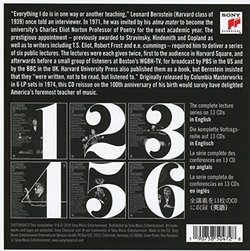| All Artists: Leonard Bernstein, New York Philharmonic Orchestra Title: Leonard Bernstein: The Harvard Lectures Members Wishing: 1 Total Copies: 0 Label: Sony Music Entertainment Release Date: 8/17/2018 Album Type: Box set Genre: Special Interest Style: Instructional Number of Discs: 13 SwapaCD Credits: 13 UPC: 190758504728 |
Search - Leonard Bernstein, New York Philharmonic Orchestra :: Leonard Bernstein: The Harvard Lectures
 | Leonard Bernstein, New York Philharmonic Orchestra Leonard Bernstein: The Harvard Lectures Genre: Special Interest Leonard Bernstein was invited to become the Charles Eliot Norton Professor of Poetry at Harvard University, Cambridge in 1971. The professorship required Bernstein to live on campus for one school year, counsel students an... more » |
Larger Image |
CD Details
Synopsis
Product Description
Leonard Bernstein was invited to become the Charles Eliot Norton Professor of Poetry at Harvard University, Cambridge in 1971. The professorship required Bernstein to live on campus for one school year, counsel students and, most significantly, deliver of a series of six public lectures. Bernstein, a ""Harvard man"" himself, was pleased and honored to become a part of this distinguished tradition. Bernstein began his residency at Harvard in the fall of 1972. He immersed himself in the academic culture with enthusiasm, and his popularity with students resulted in his being named ""Man of the Year"" by Harvard's student newspaper. Because the lectures embraced such a wide variety of disciplines, Bernstein faced the challenge of organizing his ideas into a coherent progression of six talks. Also, every word had to be written out and memorized because each of the lectures was to be presented twice: live at the University at the Harvard Square Theater, Cambridge, and then in a subsequent taping session for television at the WGBH TV Studios, Boston. Bernstein based much of the lectures on the linguistic theories Noam Chomsky set out in his book, ""Language and Mind."" In the first three lectures, Bernstein analyzed music in linguistic terms phonology (sound), syntax (structure) and semantics (meaning)--focusing on music from the Classical period. In the fourth lecture (""The Delights and Dangers of Ambiguity""), Bernstein looked at music from the Romantic period, with its heightened harmonic uncertainties and structural freedoms. The fifth lecture (""The Twentieth Century Crisis"") outlined the movement toward atonality and the crisis provoked by this crucial change in our musical language. Charles Ives' ""The Unanswered Question,"" one of the primary musical examples, became Bernstein's title for the entire series of lectures. The final lecture (""The Poetry of the Earth"") concentrated on the work of Igor Stravinsky, whom Bernstein thought had found a musical answer to ""the unanswered question,"" one that kept tonality at its center. The series ended with Bernstein's artistic and philosophical ""credo,"" an essentially optimistic and celebratory statement of beliefs. Although the very breadth of the lectures attracted some negative criticism, they were also widely recognized as an impressive achievement. Lavishly multi-disciplinary long before it was fashionable, they provided a fresh way to analyze music and interpret musical history. The Norton Lectures stand as a special monument in Bernstein's legacy.
